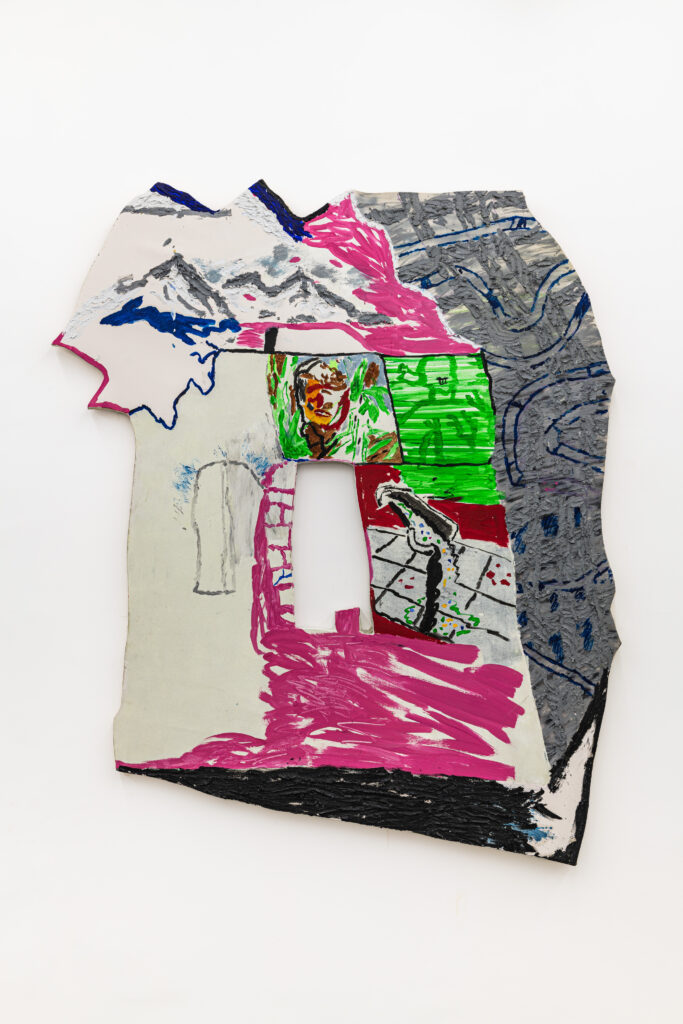Artist: Gábor Pap
Title: Notebook of escape ideas
Curator: Gábor Rieder
Venue: Artkartell Projectspace, Budapest
Photos: István András Juhász

Artkartell projectspace is happy to present the season opening solo exhibition of Gábor Pap: Notebook of escape ideas. As a member of the youngest generation of Hungarian artists, in his collection of extraordinary sincerity Pap mixes poetic destiny of Hungarian poet Attila József with the self tormenting brutality of art brut. The exhibition presents his series titled Why not, a grand sequel to his destroyed graduation thesis work: a descent to hell and a brusque ode to survival.







Gábor Pap’s art is spontaneous but also mature: it came to life from scratch in the first year of the Covid pandemic. True anti painting: enormously enlarged, intentionally brusque drawings of just a few colors on canvases with erratically meandering edges. He spreads the paint with his fingers, scratches the surface with markers, or works with broken crayons or spray paint, giving the pictures a brutally raw, expressive naivety. Instead of perfect and polished right angles, he uses irregular, jagged formats with corners and fissures. He divides the flat surface into disordered fields like plots in a backyard vegetable garden. Amidst the barely recognizable motifs, personal memory crumbs and compulsive screenshots from insomniac nights flash in automatic writing disorder: a bird behind bars and friends cooking in a cauldron, role-playing selfies and women’s magazine photos, bursting veins and South Park characters, a grandmother framed in mourning and all-seeing eyes, secret smileys and a cross-stitch pattern, the Philosopher’s Stone and Ronaldinho’s teeth, underfloor heating and a castle tower, a French garden design book and a spider web, stucco waiting to be restored and an early morning shift on an empty highway. Pap creates visual montages in a spontaneous manner, where his memories surface and come together in a flashback-like sequence. A symbolic framing element adds a third dimension to the entire composition, sometimes filled with building materials such as bricks, decorative stones, and reinforced concrete, and sometimes with the edges of pages from a notebook. The prison stones are remnants of the walls described in Attila József’s poem “Seven Towers” (You bore a stake), while the notepad with dog’s ears is the notebook – “Notebook of escape ideas” – where the original marker drawings, that served as the basis for the paintings, were made.

Attila József writes in his shockingly honest Notebook of Free Ideas, written during psychoanalytic treatment: “syrup / wake up / wake up and walk / the notebook is full / give him ten p and burn the notebook”. Unfortunately, the poet, tormented by love, poverty, and total mental uncertainty, did not burn his notebook. It survived, and its publication caused a literary scandal half a century later. Gábor Pap lives in Öcsöd, on the banks of the Körös river, in a peasant house inherited from his grandmother, just a few corners away from the former foster home of the poet. The half-orphan Attila József was sent to a peasant family in Öcsöd by the Child Protection League when he was a preschooler; he was met with a loveless environment where even his existence was questioned and he was called “Pista” instead of Attila. “It was bad in Öcsöd,” he wrote in his Notebook of escape ideas. Gábor Pap also retreated to this same decaying rural simplicity after completing his studies at the College of Fine Arts, to 6 Freedom Street in Öcsöd, to completely dissolve himself in unknown diseases and self-destructive passions, raw work and eternal insomnia. But that’s not what happened, after descending to hell, he painted raw odes of survival, not his own tombstones. He took his sketchbook of drawings, his own Notebook of free ideas, where his felt-pen sketches lay and painted them on the large, shaped canvases of his “Why not” series in early 2023.
The unique tone of Gábor Pap in Hungarian fine arts can only be compared to the art brut peasant expressionism of Menyhért Tóth or the rural concept poetry of Imre Bukta. His distant relatives are the self-destructive homeless of proletarian rage, lawlessness, and poetry, such as Francois Villon, Gyula Derkovits, Attila József or Jean-Michel Basquiat. However, Pap seeks to distance himself from any kind of aestheticized pretentiousness. “Not to add, but to take away from art history!” – he believes. “I want to create strange, degenerate images that cannot be categorized as naive or bad painting, but should not be intentionally trashy either. Definitely not supposed to be funny.” Pap’s art is more honest than bad painting, more raw than naive painting, more damaged than fashionable glitch aesthetics, and more destructive than trendy trash. The Notebook of Free Ideas is a journal of his journey through hell and a raw ode to survival. It promises to be a large-scale oeuvre.
